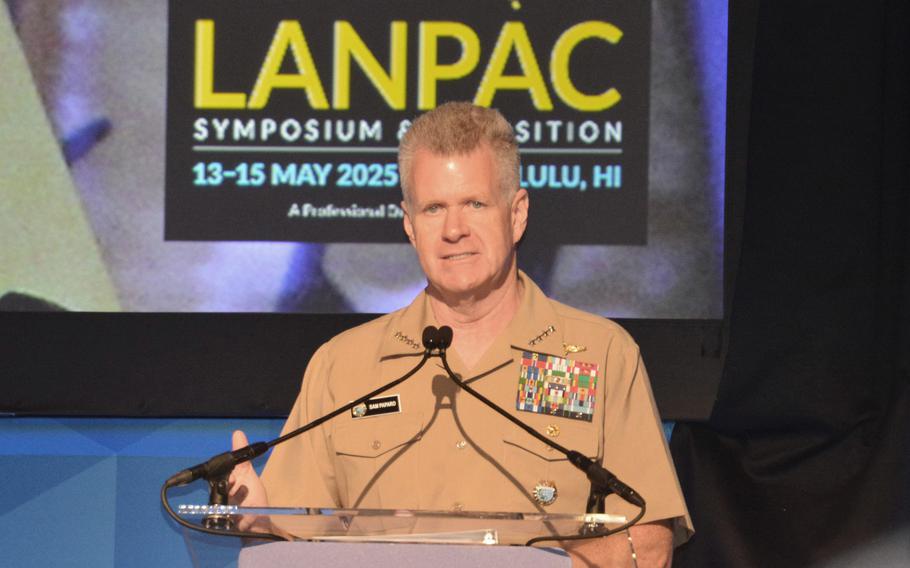
Adm. Samuel Paparo, head of U.S. Indo-Pacific Command, delivers the keynote speech at the Land Forces Pacific symposium in Honolulu, May 13, 2025. (Wyatt Olson/Stars and Stripes)
WAIKIKI BEACH, Hawaii — Adm. Samuel Paparo has a quick response when asked what he wants from the land forces under his command: firepower from field artillery, rockets and missiles.
“Fires is the capability from the Army — and from land forces — that I most treasure in this region,” Paparo, head of U.S. Indo-Pacific Command, said Tuesday in the keynote speech at the annual three-day Land Forces Pacific symposium on Waikiki Beach.
U.S. Army Pacific’s firepower, along with Army know-how in logistics and sustainment, are key to deterring and countering military aggression by China in the Indo-Pacific, Paparo told the packed audience, which included representatives from 33 armies around the world.
Paparo, since taking command of INDOPACOM a year ago, speaks often of China’s threat to Taiwan.
Beijing is on a “dangerous course” with aggressive air and sea maneuvers around Taiwan that are “rehearsals” for invasion, he told the audience.
On a single day last year, China’s army deployed 152 warships, including three-quarters of its amphibious force, Paparo said.
“More concerning is the fact that China, Russia and North Korea, among others, have formed a transactional symbiosis that threatens regional stability,” he said. “The threat is particularly acute and increasingly interconnected across our global supply chains.”
All the services would bring fire power to bear in the event of a conflict in the Indo-Pacific, Paparo said.
“And every service is indispensable to success and to deterrence,” he said.
But Paparo lauded the Army’s strides in beefing up its fires dexterity in the past decade, crediting much of that success to its multi-domain task forces.
The task forces — three are operational with two more in the works — are designed to operate across land, air, sea, space and cyberspace and are key to countering China and Russia’s area denial strategy.
A case in point, Paparo said, would be preventing an invasion of Taiwan by Chinese forces via the narrow Taiwan Strait. Beijing maintains that the self-governed island is a renegade province that must be folded into the mainland — by force if necessary.
“We don’t necessarily need immediate maritime or air superiority in the Taiwan Strait,” he said. “We just must deny its use to the [Chinese army] … and the Army’s fires capability, integrated with the other joint forces, is essential to deny that zone by imposing devastating costs across the [Chinese army].”
He described the U.S. Army’s anti-ship precision strike missiles, or PrSM, as “a gamechanger that fundamentally alters China’s risk calculus.”
“PrSM does and will allow us to strike critical nodes within China’s anti-access, area-denial, bubble — radar sites, missile launchers, command centers — potentially neutralizing them before the conflict begins,” he said.
Paparo was on hand last summer when the 3rd Multi-Doman Task Force launched two PrSMs and sank a ship off Palau during the Valiant Shield exercise.
However, he said the Army’s sustainment capabilities are just as vital.
“Army logisticians demonstrate these capabilities in ensuring the joint force can rapidly transition from competition to crisis to conflict,” he said.